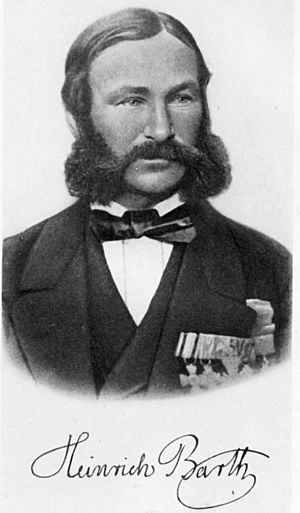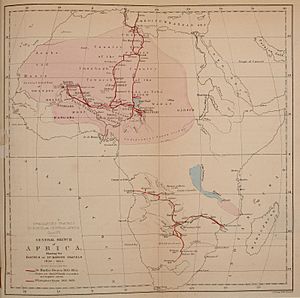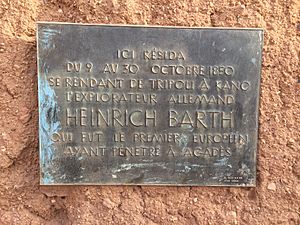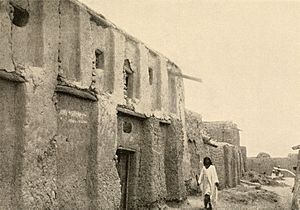Heinrich Barth facts for kids
Quick facts for kids
Heinrich Barth
|
|
|---|---|
 |
|
| Born | 16 February 1821 |
| Died | 25 November 1865 (aged 44) |
| Nationality | German |
| Occupation | African explorer and scholar |
| Awards | Patron's Medal of the Royal Geographical Society (1856) Companionship of the Bath (1862) |
Johann Heinrich Barth (16 February 1821 – 25 November 1865) was a German explorer and a very smart scholar. He is known for his amazing journeys across Africa.
Many people think Barth was one of the greatest European explorers of Africa. He was very well-prepared for his trips. He could speak and write Arabic, and he learned many African languages. This helped him carefully write down details about the cultures he visited. He was one of the first to understand how important oral history (stories passed down by speaking) was to people. He collected many of these stories.
During his five years of travel (1850–1855), he made friends with African rulers and scholars. Even after two European friends died, he finished his travels with the help of Africans. Later, he wrote a five-book series about his journeys. These books were published in both English and German. They have been very helpful for scholars ever since.
Contents
Heinrich Barth's Early Life and Learning
Heinrich Barth was born in Hamburg, Germany, on February 16, 1821. He was the third child of Johann Christoph Heinrich Barth and Charlotte Karoline Zadow. His father started from a poor background but built a successful trading business. Both parents were strict Lutherans and expected their children to be very disciplined.
From age eleven, Barth went to a famous high school in Hamburg called the Gelehrtenschule des Johanneums. He loved to study but was not very popular with his classmates. He was excellent at languages and even taught himself some Arabic. In 1839, at age 18, Barth left school and immediately joined the University of Berlin. There, he took classes from famous teachers like geographer Karl Ritter and historian Jakob Grimm.
After his first year, he paused his studies to travel around Italy. He visited cities like Venice, Florence, Rome, and Naples. He returned to Germany in May 1841. The next year, he visited the Rhineland and Switzerland. In July 1844, he earned his doctorate degree. His special paper was about the trade history of ancient Corinth.
Exploring North Africa and the Middle East
Barth planned a big trip to North Africa and the Middle East. His father agreed to pay for it. He left his parents' home in January 1845. First, he spent two months in London. There, he learned more Arabic, visited the British Museum, and got help from British officials for his trip. In London, he met Christian von Bunsen, a Prussian ambassador. This meeting would be important for his later trip to central Africa.
After London, he traveled through France and Spain. On August 7, he took a ferry from Gibraltar to Tangier in Africa. From Tangier, he traveled across North Africa by land. He also went through Egypt, going up the Nile River to Wadi Halfa. He crossed the desert to a port called Berenice Troglodytica on the Red Sea. While in Egypt, robbers attacked him and he was hurt.
He then crossed the Sinai Peninsula, and traveled through Palestine, Syria, Asia Minor, Turkey, and Greece. Everywhere he went, he studied old ruins. He returned home to Hamburg on December 27, 1847, after almost three years of travel. He later wrote about some of his travels in a book called Wanderungen durch die Küstenländer des Mittelmeeres (Walks through the coastal states of the Mediterranean). This book was published in 1849.
His Amazing Journey Across Africa

Christian Bunsen, the Prussian ambassador, helped Heinrich Barth join an expedition. This trip was led by James Richardson, an explorer of the Sahara. The British government wanted Richardson to start trade with the countries in central and western Sudan. Barth and another Prussian astronomer, Adolf Overweg, joined the group.
The team left Marseille in late 1849 and started from Tripoli in early 1850. They crossed the Sahara Desert with great difficulty. Barth arrived in the city of Agadez in October 1850 and stayed for several days. Today, a special sign honors him as the first European to enter that city.
Sadly, Richardson died in March 1851, and Overweg died in September 1852 from unknown illnesses. This meant Barth had to continue the scientific mission all by himself. Barth was the first European to visit Adamawa in 1851.
When he returned to Tripoli in September 1855, his journey had covered a huge area. He traveled from Tripoli in the north to Adamawa and Cameroon in the south. He also went from Lake Chad in the east to Timbuktu (which he reached in September 1853) in the west. This was more than 12,000 miles of travel! He carefully studied the land, history, cultures, languages, and resources of the places he visited. His success as an explorer and historian came from his patient personality and his excellent education.
Barth was very interested in the history and culture of African people. He didn't just focus on how to make money from the land. Because he wrote down so many details, his travel journals are still very important for studying 19th-century Sudanic Africa. He was one of the first European visitors to pay attention to local oral traditions. He also seriously thought about how to use these spoken stories for historical research. Barth was the first true European scholar to travel and study in West Africa. Earlier explorers did not have the same academic knowledge.
Barth spoke Arabic very well and knew several African languages, including Fulani, Hausa, and Kanuri. This allowed him to learn about the history of different regions, especially the Songhai Empire. He became good friends with many African scholars and rulers. This included Umar I ibn Muhammad al-Amin in Bornu, and leaders in the Katsina and Sokoto regions, all the way to Timbuktu. In Timbuktu, his friendship with Ahmad al-Bakkai al-Kunti meant he could stay in his house. Al-Kunti also protected him when someone tried to capture him.
After returning to London, Barth wrote and published his travel stories. They were released at the same time in English and German. The title was Reisen und Entdeckungen in Nord- und Centralafrika (Travels and Discoveries in North and Central Africa). It was five books long, with about 3,500 pages. The books included colorful pictures drawn by Martin Bernatz, based on Barth's original sketches. This work was considered one of the best of its kind. Even Charles Darwin mentioned it. Historians of Africa still use it today. It is an important scientific work about African cultures from that time. It also showed for the first time that the Sahara Desert was once a green savanna.
Later Years and Lasting Impact
After his travels, Barth returned to Germany from Great Britain. He worked on collecting and organizing words from Central African languages. This was published between 1862 and 1866. In 1858, he took another trip to Asia Minor. In 1862, he visited Turkish areas in Europe. He wrote about these travels, and the book was published in Berlin in 1864.
The next year, he became a professor of geography at Berlin University. He was also made president of the Geographical Society. However, he was not allowed to join the Prussian Academy of Sciences. They said he hadn't done enough for history or languages. They didn't fully understand how important his achievements were, but scholars since then have recognized his great work.
Heinrich Barth died in Berlin on November 25, 1865, when he was 44 years old. His grave is in a Protestant cemetery in Berlin-Kreuzberg.
Awards and Remembering Barth
- In 1856, he received the Patron's Medal from the Royal Geographical Society for his African journeys.
- In 1862, the British government gave him the Companionship of the Bath.
Barth is also remembered in the scientific name of a type of African venomous snake, called Polemon barthii.
See also
 In Spanish: Heinrich Barth para niños
In Spanish: Heinrich Barth para niños





